Your chickens will need properly formulated chicken feed that is the correct type for their age, for growth, sustenance and to produce eggs if they are hens of egg laying age. There are many old wives tales and alternative views on feeding, some say it’s marketing that has created all of these feeds and hens will survive well on wheat and others will say their grandad never had layers pellets and just fed his hens kitchen scraps! Formulated poultry feeds didn’t exist until recently, primarily created thanks to commercial research on hens diets as we tried to squeeze more and more eggs out of hens.
In days gone by though when ‘grandad fed scraps’, pure breeds were kept for eggs and they were fed grain mixes or dried mash chicken feed that had meat or fish meal added to increase the protein content. Hens would free range over a large area and could also supplement their diet with what they could forage. Bugs, insects and worms are all valuable sources of protein, not forgetting a good selection of greens providing vitamins and minerals.
“Grandad’s chickens didn’t get chicken feed and survived on kitchen scraps but they could free range to top up their diet on protein, vitamins, minerals and calcium from the fields or orchards they grazed. They didn’t produce anything like the number of eggs modern hybrid hens or some pure breeds produce.”
So in short, if you don’t feed a proper formulated layers feed to your hens, they won’t be able to keep up the demands that egg-laying puts on their bodies.
Layers Feeds and Protein
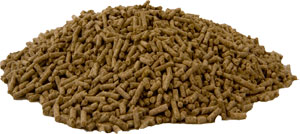 Chickens require protein to produce feathers and eggs as well as to grow. The amount of protein in their diet is important and you will see on the ingredients on the back of bags of commercial feeds the percentage of protein that they contain. It is higher in ‘Growers Pellets’ for example to enable chickens to grow and produce feathers. You will find that chickens stop laying eggs when they moult (lose their feathers and regrow new) as they are diverting protein from egg production to feather production. During the moult, you can scatter a handful of cat kibble in the run which helps them to top up with protein. Do not use dog food as most of the protein is derived from cereals.
Chickens require protein to produce feathers and eggs as well as to grow. The amount of protein in their diet is important and you will see on the ingredients on the back of bags of commercial feeds the percentage of protein that they contain. It is higher in ‘Growers Pellets’ for example to enable chickens to grow and produce feathers. You will find that chickens stop laying eggs when they moult (lose their feathers and regrow new) as they are diverting protein from egg production to feather production. During the moult, you can scatter a handful of cat kibble in the run which helps them to top up with protein. Do not use dog food as most of the protein is derived from cereals.
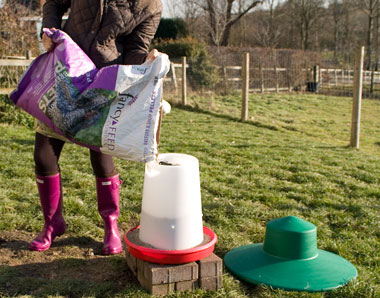
Commercial feeds contain the right balance of nutrients & can be fed ad-lib in hoppers if kept dry. This one has a rain hat.
Commercial chicken feeds have been well researched and contain the correct balance of minerals and nutriets required by chickens as well as sufficient protein and calcium which is essential for egg shell production. Layers pellets for example are around 16% protein. Wheat is about 10% protein and lacks essential vitamins that are required by chickens.
Formulated feeds come as pellets or mash and should be fed ad-lib so hens can take what they want as they need it. This type of feed must be kept dry or it will soon spoil. The feeder and rain hat shown above is the only sort I have found that really does keep the feed dry. Most have a hole in the top of the hat for a handle or for hanging and this lets water in. A feeder and rain hat similar to this one can be bought from Omlet.
Eggs are made up of around 80% protein so if there’s a shortage of protein in their diet, egg laying will be the first thing they your girls cut back on!
There is more information on the poultykeeper.com site which has a very good page of feeding chickens and chicken feed.
Mixed corn
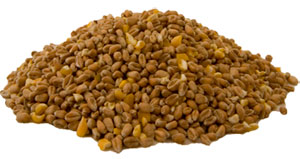 Mixed corn is usually 80 to 90% wheat and 10 to 20% maize. It is useful as a scratch feed, it keeps hens active, scratching around looking for it but should only be considered a treat. A handful per hen thrown late afternoon helps them to have a full crop overnight.
Mixed corn is usually 80 to 90% wheat and 10 to 20% maize. It is useful as a scratch feed, it keeps hens active, scratching around looking for it but should only be considered a treat. A handful per hen thrown late afternoon helps them to have a full crop overnight.
The maize (yellow in colour) is very fattening but can be useful during very cold weather to help your hens keep warm – I increase my girls’ ration of corn when it is cold over the winter, after they have finished moulting (they need lots of protein during the moult) since they are not laying eggs and need a little extra fat to burn in order to keep warm.
If you feed too much corn, your hens will get fat and fat hens don’t lay eggs!
Household scraps
Feeding household scraps is no longer allowed according toi DEFRA and can be a bit hit and miss anyway. You don’t really know what a hen is getting and the diet is very unbalanced. It is for this reason that scraps used to be mixed into a mash by using layers mash and water (which can be warm in winter). The mixture should be a sort of crumbly mix, not too wet but not too dry. Feeding scraps should be limited to at most 25% of a hens diet so as not to tip the balance too far one way or another.
Greens
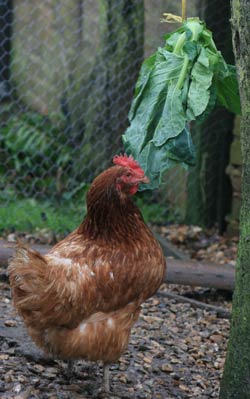 Ample green stuff should be provided for your hens. Grass cuttings, weeds and off-cuts from cabbages, cauliflowers and other greens can be provided at minimal cost. Lettuce should be fed in moderation because it has very little nutritional value (very little Protein and Energy / Calories) and avocado pear is poisonous to hens but most other greens that come from the kitchen will be appreciated by your girls. Try hanging greens in their run, just a little higher than they can reach. As they eat them, they will need to jump to get the last bits so will be getting exercise at the same time as their greens! Win-win!
Ample green stuff should be provided for your hens. Grass cuttings, weeds and off-cuts from cabbages, cauliflowers and other greens can be provided at minimal cost. Lettuce should be fed in moderation because it has very little nutritional value (very little Protein and Energy / Calories) and avocado pear is poisonous to hens but most other greens that come from the kitchen will be appreciated by your girls. Try hanging greens in their run, just a little higher than they can reach. As they eat them, they will need to jump to get the last bits so will be getting exercise at the same time as their greens! Win-win!
If you have an area in which you can grow cabbages in your garden, it may be worthwhile thinking about growing a row for the winter. Cabbages will sit there in the cold, perfectly preserved until picked. You will need to keep them covered with fleece when there are cabbage white butterflies around but don’t worry if they are a little eaten, the chooks won’t mind!
Mealworm treats
Many chicken keepers like to buy mealworms or chicken treats containing these. Chickens love these and are easily tamed by using such tasty treats, however you should keep in mind that animal by-product regulations mean that mealworms are not really allowed to be fed to poultry.

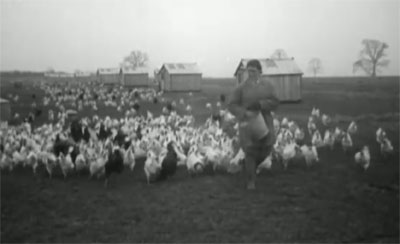

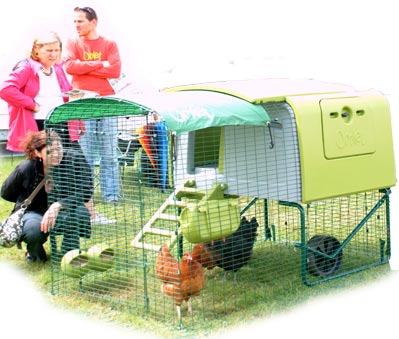


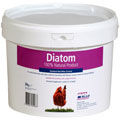
Thanks for a really informative website. I took alot of your advice whilst setting up my own coup. I’ve had 3 hens for about 2 months now, and everything is going really well. However, I also appear to now be feeding an increasing population of wild birds. The odd sparrow was not an issue, but now scores of pigeons, magpies and crows amongst others literally queue up for a feed.
I have an enclosed garden, and so my girls are free to roam all day. I currently leave the pellets out from when I let them out in the morning, until I shut them away at night.
Do you have any suggestions?
Yes, it can be a problem. I use a rat proof feeder (grandpas feeders make a good one) that they can be trained to use in one of my more exposed runs but in others, I simply move the feeders inside the coop where it is harder for the wild birds to get to them.
Hi, I am a complete novice and this website is brilliant!!
I have a large area of rough brambles and fern on a steep boggy slope, near to where I want to keep the hens. When free ranging will the hens suffer with anything similar to foot rot on soggy land or infections from thorns? It’s very dense growth and about four feet high in rough ferns and brambles, and very well populated with snails, which I hope they will like.
Regards
Neil C
I would cut back a little to allow the hens to get onto the ground and scratch around. They should be OK as long as it doesn’t get too muddy. They can get cuts on their pads which can become infected (called bumblefoot) but generally, they should be fairly robust.
I am a recent suburban egg laying chicken owner and my girls
have just started to lay eggs. I have been grinding dried egg shells
to give them for some additional calcium suppliment; however,
I am uncertain how best to introduce powdered shell to their diet.
Any suggestions?
You can crush baked / dried egg shells and put them in a bowl for them to pick at as and when they need them. I use grit hoppers for mine.
is there any plants/flowers that will harm chickens thanks
There are, however they are usually pretty smart at knowing what not to eat.
I have been keeping hens for just over a year. They are a mix of ex-battery & ex-free range from about 18 months when I got them. I should like to pass on a piece of advice about feeding. I DO NOT feed them ad-lib now but measure the feed 100-125g per bird per day. This is because before I got them they were fed a set amount several times a day and ate everything they were given. When I tried to feed them ad-lib they ate too much, put on too much weight, laid massive eggs and several died of peritonitis from being ‘egg-bound’ before I realised what the cause was. I was literally killing them with kindness! I hope this helps other new hen keepers.
Pellets or mash can be fed ad-lib and they shouldn’t over eat. The composition is such that they get full before they can eat too many calories. Corn and other treats should be limited as they can get fat. Maize for example is particularly fattening.
I wish you were right, but they do over feed on pellets! I was getting eggs in excess of 80g in weight and lost 3 hens before I restricted their layers pellets. Now I get eggs of 60 to 75g and they only get mixed corn a couple of times a week (though they do get plenty of greens) and I haven’t lost a single hen! If the eggs drop below 60g, I give them extra but that doesn’t happen very often. What can I say? – it works for me and my girls…
If it works for you, then stick with it 🙂